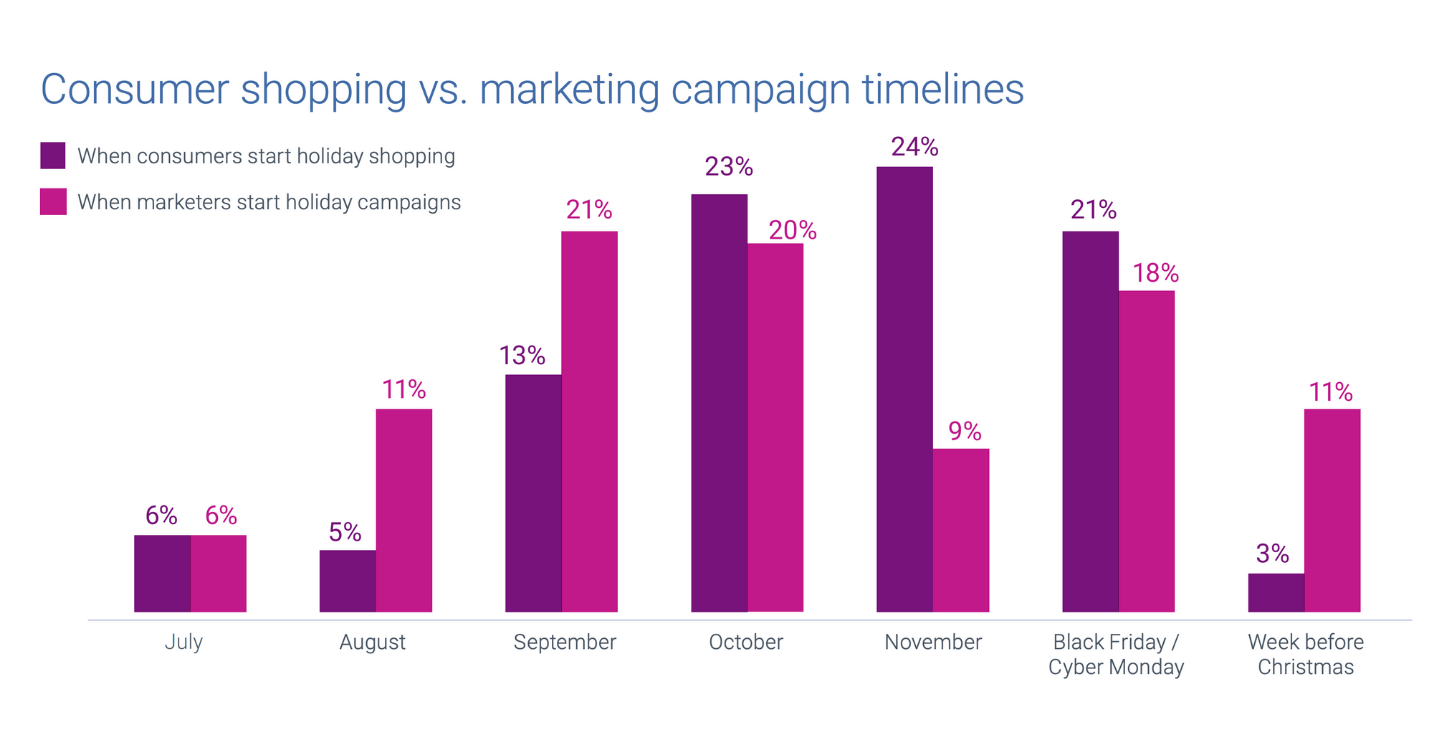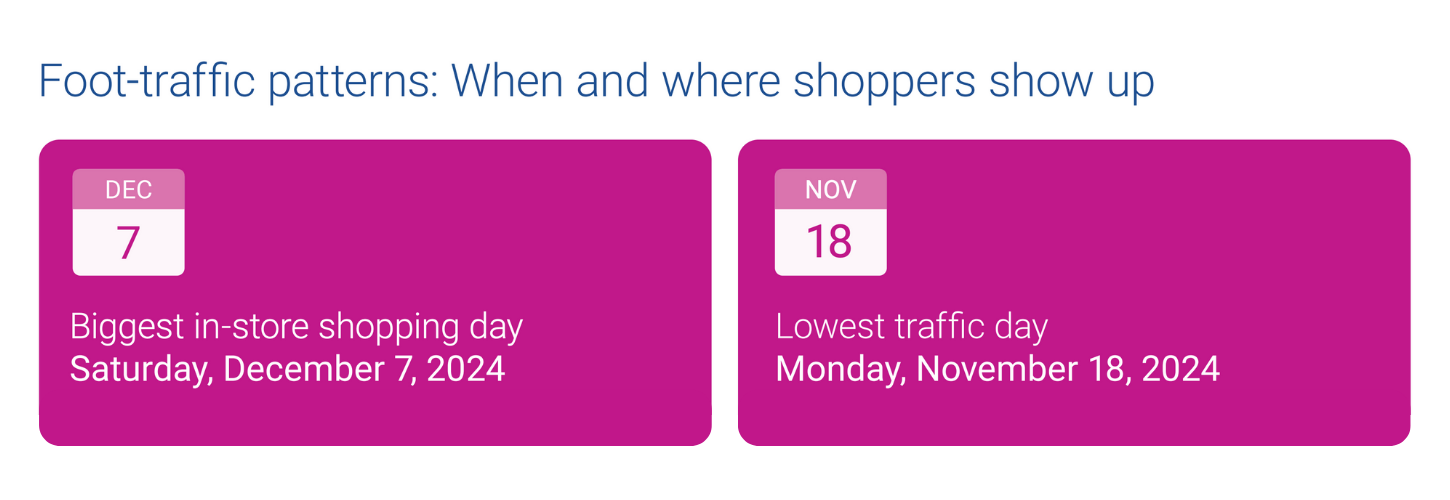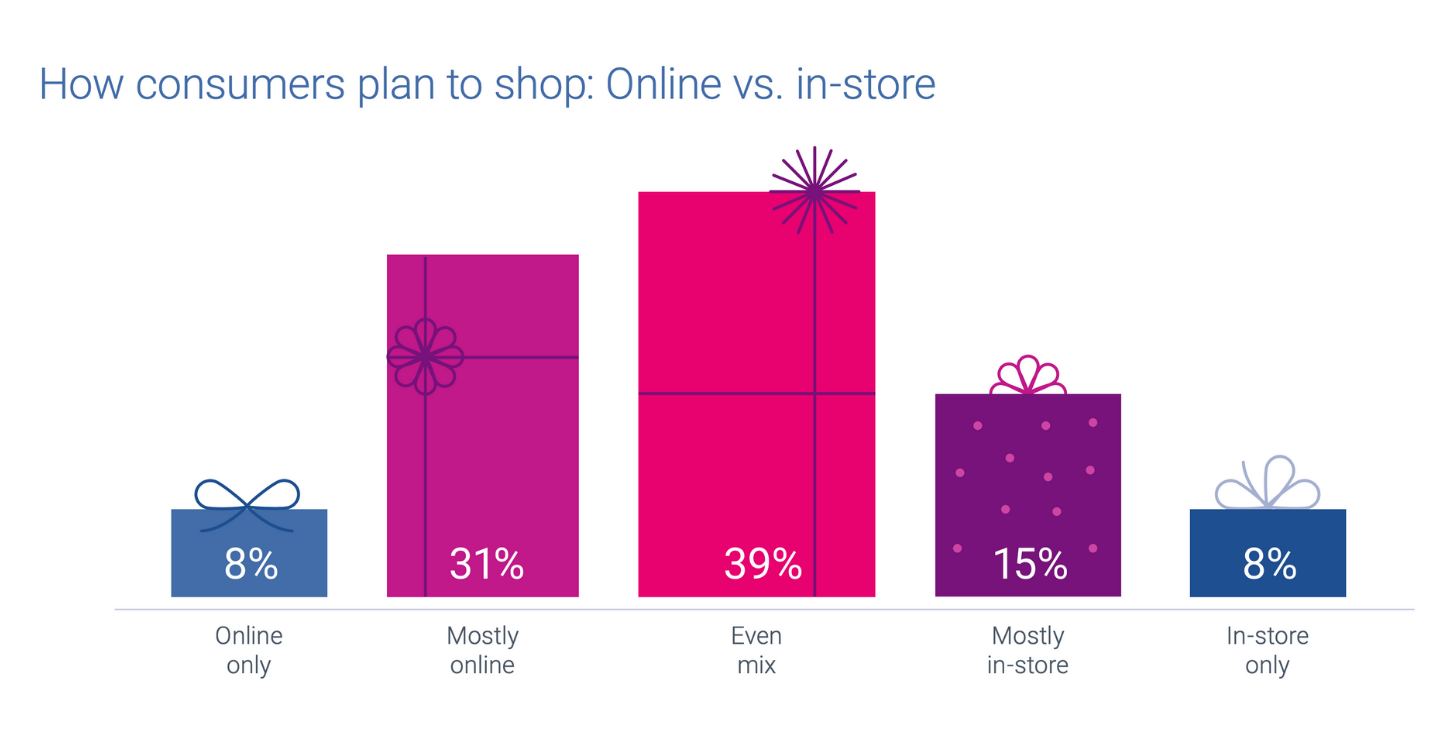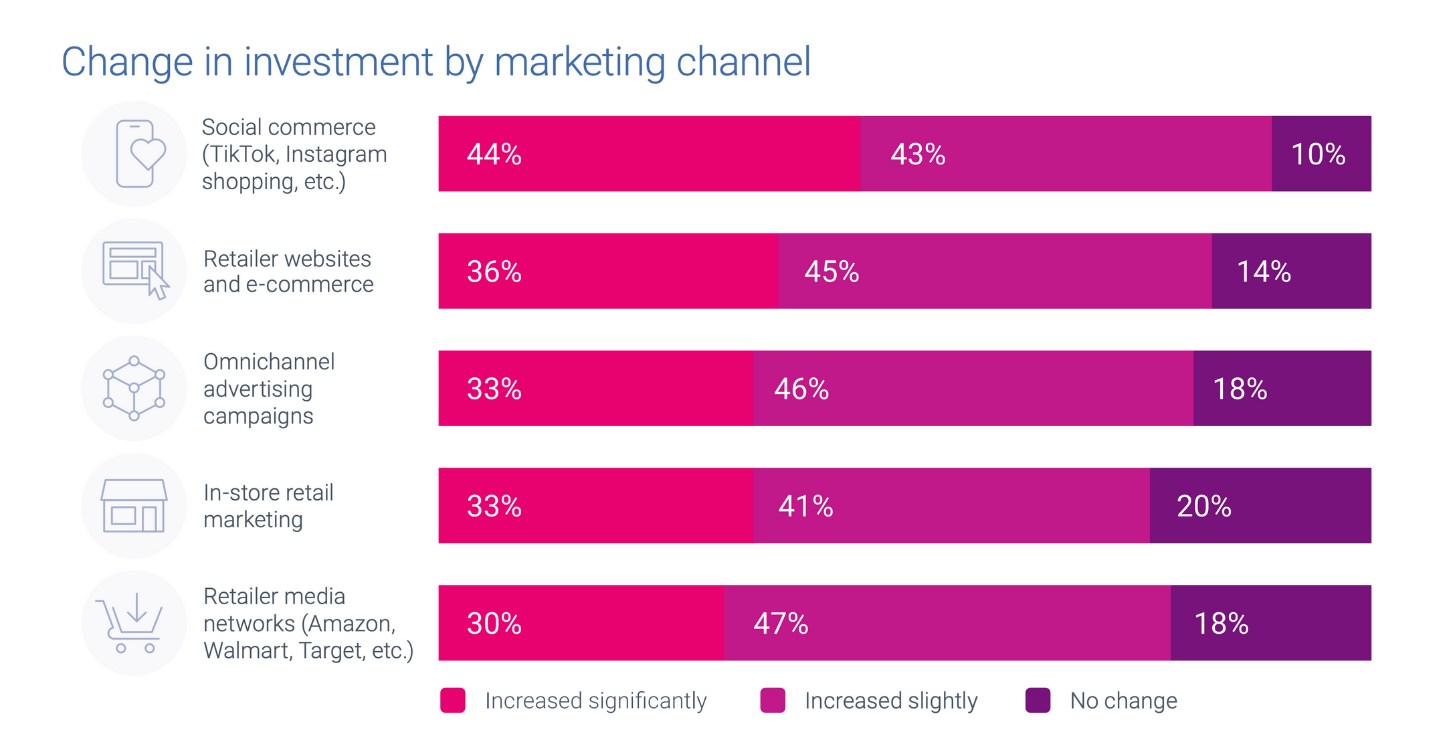At A Glance
Holiday shopping in 2025 doesn’t follow one clear pattern, with shoppers blending early planning and last-minute purchases, digital discovery and in-store validation, and cautious spending. Marketers who embrace this complexity, by staying relevant, consistent, and connected across channels, will be best positioned to win this season.Holiday shopping in 2025 feels a lot like a complicated relationship. Shoppers want deals, but they also want trust. They start shopping early, but they’re still browsing well into December. They love the convenience of online shopping, but they still show up in-store before making the final call.
Our 2025 Holiday spending trends and insights report, created this year in collaboration with GroundTruth, explores these contradictions. Our findings show that this year’s holiday season isn’t about one big shift; it’s about managing the push and pull between what consumers say, what they do, and how marketers respond.
Here are three complicated truths you need to know.
Experian’s 2025 Holiday spending trends and insights report
Optimize your 2025 holiday shopping campaigns with our latest report with GroundTruth.
Download now1. The new rules of holiday timing
Almost half (45%) of consumers plan to start shopping before November, but 62% admit they’ll still be buying in December. And post-holiday shopping (think gift card redemptions and deal-hunting) remains a real factor.


Why it’s complicated
The holiday calendar isn’t what it used to be. There’s no single “big moment” anymore. Instead, shoppers are spreading purchases across months, peaking around the “Turkey 12” (the 12 days surrounding Thanksgiving) and again in the final December rush.
What to do about it
- Stretch your campaigns across the full season, not just Cyber Week.
- Refresh offers to stay relevant as shopper motivations change from deal-seeking to last-minute urgency.
- Watch for post-holiday momentum and extend your promotions into January.
How belVita nailed the timing
In celebration of National Coffee Day, belVita partnered with GroundTruth on a one-month campaign to boost product awareness and drive foot traffic to Target stores. By utilizing digital out-of-home (DOOH) and mobile ads powered by location, behavioral, and purchase-based targeting, the campaign achieved a 3.44% visitation rate, nearly $476k in products added to carts, and a low cost-per-visit of just $0.22.
2. Online leads, but in-store still seals the deal
Nearly 40% of shoppers say they’ll split their purchases between online and in-store and 80% of consumers still prefer the in-store experience. Only a small fraction plan to shop exclusively in one channel. That means while digital often starts the journey, the final decision often happens in a physical store.

Why it’s complicated
Shoppers love the convenience of browsing online, but they still want the reassurance of seeing, touching, or testing products before buying. In-store isn’t just about the transaction, it’s the validation step.
What to do about it
- Build omnichannel strategies that connect digital discovery with in-store follow-through.
- Use location and identity data to tie digital impressions to real-world actions, like foot traffic and purchases.
- Focus on consistency: shoppers expect the same value, tone, and trust whether they’re on a website, in an app, or standing in a store aisle.
How Duke Cannon used on-premise targeting to drive sales lift
Duke Cannon, a premium men’s grooming brand, partnered with GroundTruth to launch a successful multichannel campaign utilizing location-based and behavioral audience targeting across CTV and mobile screens to drive in-store visits and sales.
By targeting consumers with mobile ads while they were physically in-store, the company capitalized on high purchase intent, aiding in the 12% sales lift. This strategic approach resulted in over 43.9k provable in-store visits and a significant increase in sales.
3. Marketers double down, consumers hold back
This holiday season, expectations are split. 66% of marketers expect holiday spend to rise, but only 22% of consumers agree. While brands are leaning into bigger investments across CTV, retail media, and social, shoppers are staying cautious, weighing value and waiting for the right deal.

Why it’s complicated
That disconnect introduces risk. If marketers don’t align spend with real consumer behavior, budgets can get wasted in the rush to cover every channel. Shoppers haven’t stopped spending, but they’re spending differently. They’re trading down to discount and big-box retailers while cutting back in discretionary categories like apparel and restaurants.
What to do about it
- Prioritize efficiency by focusing on the right audiences, not just more impressions.
- Make consistency your advantage: reach people once and connect across platforms instead of chasing fragmented signals.
- Balance aggressive media investment with messaging that acknowledges consumer caution — shoppers want value and trust, not hype.
Measuring TV and streaming impact with iSpot
iSpot’s Audience Builder, powered by Experian’s Marketing Attributes, helps brands reach high-value audiences. During the holiday season, a luxury retailer could target $100K+ households with affluent lifestyle interests. With iSpot’s Unified Measurement platform, they can track performance across linear TV and streaming and shift spend in real time to maximize results.
The bottom line on 2025 holiday shopping trends
This year’s holiday shopping season is, well…complicated. Shoppers are cautious but still engaged. They’re early planners and last-minute browsers. They want the ease of digital, but the confidence of in-person.
For marketers, the opportunity lies in embracing that complexity, not trying to simplify it away. The brands that balance relevance, trust, and convenience across the full season and across every channel will be the ones that win.
Download our full 2025 Holiday spending trends and insights report to explore all five shifts shaping this season and see how you can turn complexity into opportunity.
About the author

Fred Cheung
Director, Partnership Sales, Audigent, a part of Experian
Fred Cheung has spent over a decade in the programmatic advertising space, with roles at Mindshare, Jounce Media, Twitter, and The Trade Desk. His deep experience in trading and product management helps in his current function on the Experian Marketing Services’ Sales team where he focuses on data growth and adoption across the industries’ leading buy-side platforms.
2025 holiday shopping trends FAQs
Because consumer behavior is full of contradictions. People will shop earlier but also later, browse online but purchase in-store, and want deals while demanding trust. Marketers need to navigate these push-and-pull dynamics.
Nearly half (45%) say they’ll start before November, but 62% admit they’ll still be buying in December, with momentum even continuing into January through gift card redemptions and deal-hunting.
Although many consumers begin online, the majority still make their final decisions in-store. In-person shopping acts as a validation step where customers can see, touch, or try products before buying.
Instead of focusing only on Black Friday or Cyber Week, marketers should stretch campaigns across the full season, refresh offers frequently, and continue promotions into January.
Not entirely. 66% of marketers expect spending to rise, but only 22% of consumers agree. Shoppers are cautious, prioritizing value and often trading down to discount or big-box retailers.
An omnichannel approach using identity and location data can bridge digital impressions with real-world actions like store visits and purchases, ensuring consistency across touchpoints.
Brands like belVita and Duke Cannon successfully tied digital campaigns to in-store results by utilizing precise audience targeting, location data, and well-timed promotions.
You can download Experian’s 2025 Holiday spending trends and insights report to explore all five shifts shaping this season.
Latest posts

What generation already has 68 million consumers, is set to be the largest generation ever, and $360 billion of disposable income? While you may think these attributes describe millennials, they are actually a portrait of Generation Z, better known as Gen Z, the newest generation that is emerging in the marketplace. Gen Z is beginning to make an impact worthy of focusing your next auto marketing campaign around. Gen Z and the automotive market Made up of consumers born after 1996, Gen Z is ready to be noticed and become a force to be reckoned with in the market. In the automotive market alone, Gen Z made up 3.8 percent of all new vehicle registrations in the first quarter of 2019. While that number may seem small, consider the fact that in 2015—just four years ago—they only made up 0.5 percent of new vehicle registrations. These are statistics that should make automotive marketers pay attention. Digital consumption of Gen Z Most marketers tend to lump Gen Z with millennials – after all, they grew up with smartphones and social media, so how different can they be than the generation that came of age with the Internet? However, unlike millennials, Gen Z is considered a true “digital generation” – performing many of life’s day-to-day activities online. This means that they do a lot of research when shopping for a product. In fact, according to the Center for Generational Kinetics, 52 percent of Gen Z has looked at online reviews for a product while shopping in-store. But how do digitally native consumers impact automotive marketers? In order to sell cars, marketers’ messages need to be relevant. Like many other generations, Gen Z interacts with brands across a number of different devices and touchpoints. They’re constantly bombarded with messages and advertisements, so much so that it becomes information overload. Auto marketing to Gen Z To create consistent messages that resonate, brands need to communicate across these different touchpoints and tell a story that is relevant to your audience. For example, you wouldn’t show an advertisement of someone buying their dream sports car to a member of Gen Z. Most of these consumers are buying their first car, so it would typically make more sense to show them ads for economical, reliable, sedans or cross-over SUVs. Historically, automotive marketers have relied exclusively on CRM data, but this strategy isn’t effective when it comes to Gen Z, the fact of the matter is that they probably haven’t purchased a car from you previously. Identity resolution and Gen Z auto marketing The recipe for marketing success with Gen Z is identity resolution – combining your first-party identity signals across channels with third-party resources, as well as advanced technology, such as machine learning and artificial intelligence, to truly create and deliver campaigns that are relevant to the youngest generation. The more knowledge marketers have on your audience, such as demographics, life events and purchase behavior, enables them to tailor the messages to the audience in a way that will cut through the noise and resonate. As more members of Gen Z come into the marketplace, automotive marketers will want to ensure they’re meeting them where they are, delivering messages that matter to them. This will help marketers not only sell more cars, but also begin to create relationships that could last for years to come. Your identity resolution partner Experian is here to help you create an identity resolution strategy that will take your automotive marketing campaigns to the next level. We help brands put real people at the center of their business by resolving fragmented identity signals. Deliver personalized, relevant messages across channels to effectively target your ideal customers. Get started with identity resolution today! Contact us today

As summer fades, marketers are gearing up for another campaign cycle. It’s a process that repeats itself annually, but we can’t just copy-and-paste our plans. With each passing year, the media landscape changes drastically, as do the behaviors of the audiences we are trying to reach. As ever, marketers have to be strategic—and nimble—to reach the right customers at the right time, with messaging central to seasonal events and personal preferences. Marketers can ensure their messaging reaches the right customers with audience optimization. Reach target audiences this season It can be a hassle to create custom audience segments and bespoke creative messaging every time the seasons change, but now, more than ever, we must ensure brand campaigns are as timely, relevant and personalized as possible. In a world of multitasking and multiscreening, there’s an expectation among consumers that all communications they receive are relevant to them—especially from brands. This is why it’s critical to understand your audiences and how to engage them through the most effective channels. To help marketers win the battle for consumer attention—and sales—4C developed the Scope platform. This self-serve software arms brands with powerful tools for managing audiences and optimizing campaigns across channels including TV and digital. So, whether it’s building an efficient media plan, buying targeted ads, or measuring business outcomes, audience optimization is truly in scope. Deliver audience-based marketing messages across the TV and video space Recently, 4C teamed up with Experian to expand our audience marketplace across linear TV, OTT and social media. Brands using the Scope by 4C™ platform can leverage Experian data across a variety of planning and buying use cases, including audience-based linear TV planning and programmatic scatter buying; OTT campaigns across FreeWheel, Telaria, and SpotX; and social advertising on Facebook, Twitter, and Pinterest. Scope’s TV Planner allows marketers to combine historical cost and ad occurrence data with Experian audiences to create customized TV plans in minutes. The outputs go beyond GRPs to maximize in-target impressions for a secondary audience as well as indexing high against the primary demo. With audience-based TV planning brands can truly maximize their upfront buys and use the fantastic reach of linear television for seasonal performance marketing, not just brand awareness. OTT harnesses the big-screen, living-room impact of TV with the targeting precision and flexibility of digital. By using Experian segments to create OTT audiences in Scope, brands can really focus on creative strategy, using the immersive power of video to drive specific business outcomes. From a social perspective, we can combine the pinpoint targeting marketers have come to rely on from platforms like Facebook with advanced segmentation enabled by Experian. The output is high-performing audiences that can be reached at scale with dynamic creative to achieve unparalleled ROI. Focus marketing strategies on audience optimization this season Leveraging customized audiences across channels is the modern approach to marketing and has completely shifted the way marketers target consumers. With the relationship between 4C and Experian, there is now a better way for marketers to identify the most valuable potential customers, uncover the most appropriate messaging, and execute campaigns across the most engaging channels – during peak seasonal campaigns and every single day. Contact us today

With Tapad, part of Experian, technology, AdsWizz AudioMatic is the first Audio buying platform to offer cross-device identity resolution across the U.S. and EMEA NEW YORK and LONDON, July 17, 2019 /PRNewswire/ — Tapad, part of Experian and a global leader in digital identity resolution, today announced a new joint capability with AdsWizz , the leading technology provider for digital audio advertising solutions. The partnership combines Tapad's digital cross-device technology with AdsWizz's AudioMatic buying platform, enabling the ability to connect audio ad experiences across screens. AudioMatic, AdsWizz's audio-centric buying platform, supports programmatic audio buying and entirely new audio ad experiences for listeners. The integration of The Tapad Graph onto its platform enables new opportunities for marketers to reach, engage and measure each interaction with their desired consumers on digital radio and podcasts channels, and across devices. This partnership makes AdsWizz the first audio buying platform to offer this enhanced cross-device identity capability in the US and EMEA markets. "Marketers need privacy-safe digital identity resolution to reach their consumers," says Tom Rolph, VP of EMEA at Tapad. "With audio becoming an increasingly powerful medium for engagement, it's important that our technology extends to this channel, which is why we are excited to announce our integration with AdsWizz's AudioMatic platform." Digital audio is experiencing high growth, with 84% of advertisers and agencies saying it will play a bigger role in their media plans in the future. Today, 60% of digital audio is consumed via a mobile device.* The Tapad Graph is the largest digital identity resolution graph with differentiated global scale. The partnership enables audio advertisers to leverage The Tapad Graph for enhanced attribution, analytics, and targeting. Alexis van der Wyer, CEO at AdsWizz, added, "Digital audio is increasingly becoming ubiquitous in our media consumption and in our daily digital interactions, and because of that, audio advertising offers tremendous opportunity to personally interact with consumers in every moment of their daily lives. By integrating with Tapad, we enable our advertising partners to increase the effectiveness and the relevance of their marketing messages across audio channels." To learn more about Tapad and our digital identity resolution products, visit our identity solutions page. *Digital Audio Exchange, "The Rise of Digital Audio Advertising," https://thisisdax.com/wp-content/uploads/2019/07/DAX-Whitepaper.pdf About Tapad Tapad, Inc. is a global leader in digital identity resolution. The Tapad Graph, and its related solutions, provide a transparent, privacy-safe approach connecting brands to consumers through their devices globally. Our one-of-a-kind Graph Select offering enables marketers the flexibility and freedom of choice to correlate devices to varied objectives, driving campaign effectiveness and business results. Tapad is recognized across the industry for its product innovation, workplace culture and talent, and has earned numerous awards including One World Identity's 2019 Top 100 Influencers in Identity Award. Headquartered in New York, Tapad also has offices in Chicago, London, Oslo, Singapore and Tokyo. About AdsWizz: AdsWizz has created the end-to-end technology platform that is powering the digital audio advertising ecosystem. AdsWizz powers well-known music platforms, podcasts and broadcasting groups worldwide with a comprehensive digital audio software suite of solutions that connect audio publishers to the advertising community. From dynamic ad insertion to advanced programmatic platforms to innovative new audio formats, AdsWizz efficiently connects buyers and sellers in digital audio. AdsWizz is headquartered in San Mateo, California, with an IT Development hub in Bucharest, Romania, and presence in 39 markets around the world. About AudioMatic: AdsWizz Demand Side, audio-centric DSP and audio buying platform, AudioMatic, enables programmatic audio buying and entirely new audio ad experiences that are proven to be more engaging and more effective, and have delivered measurable results for agencies and their brands all over the world. All the biggest ad agencies have used our programmatic trading platform, including Omnicom, GroupM, Havas, Publicis, Mobext, and more. Contact us today